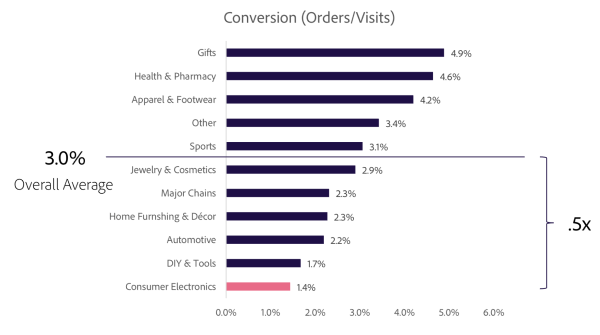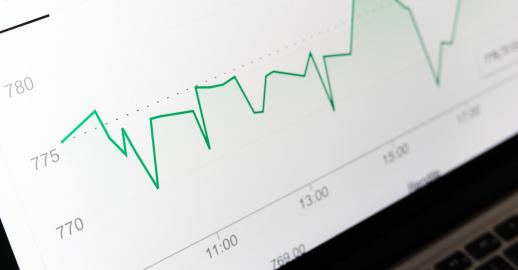
15th June 2020
Where to Focus Your Conversion Rate Optimisation for Increased Marginal Gains
What is CRO?
Conversion Rate Optimisation (CRO) is the process of improving your conversion rate. Conversion rate is the percentage of visitors to your website who perform a key action. Moz breaks conversions down into two categories – macro and micro conversions.
Macro-conversions are the most valuable actions taken on your website and could include:
- Buying a product online
- Getting a quote online
- Signing up for a service
Micro-conversions are smaller, less valuable conversions that can occur higher up the purchasing funnel such as:
- Website click to call from mobile devices
- Newsletter signups
- Brochure or catalogue downloads
- Creating an account
- Adding products to a cart ahead of the checkout process
How is conversion rate calculated?
Conversion rate is calculated using the following formula:
(Conversions/Website Sessions) x 100 = % Conversion Rate
For example, if a website had 1,000 sessions and in 30 of those sessions the users ended up buying online, we could calculate it as:
(30/1,000) x 100 = 3% conversion rate
The importance of CRO for marginal gains
The fundamental basis of CRO is efficiency – generating more sales, calls and enquiries with fewer or the same number of website sessions (which means you can get more revenue without dramatically increasing your budget). It’s simply the single best action you can take to improve the performance of your online business.
That’s not to say it’s easy, though. Compared with other online metrics, conversion rate can be a tough one to improve upon. And even when you do, the positive shifts in conversion rate may look too small to be deemed a success. Don’t lose hope, though, because incremental improvements build up over time – an increase from 2% to 2.5% may not feel like much in the short term, but over the course of a year it really does make an impact on your online performance and bottom line.
Let’s consider an example:
You are an online retailer whose website generates 100,000 visitors a year with a conversion rate of 2%, where conversions are website sales, and the average order value is £50. We can implement the formula from earlier:
(Conversions/Website Sessions) x 100 = % conversion rate
Which becomes:
(Website Sessions x % Conversion Rate) = Conversions
(100,000 x 2%) = 2,000 sales
From there we can multiply the sales total by the average order value to find out the total website revenue:
2,000 x £50 = £100,000
So, we can see that at a 2% conversion rate, our website would generate £100,000. Now, what if we improved the conversion rate to 2.5% through incremental changes to the website?
(100,000 x 2.5%) = 2,500 sales
2,500 x £50 = £125,000
We can see that the same number of website sessions has led to a £25,000 increase in revenue throughout the year.
CRO is especially important from a PPC perspective, as the results are more tangible. Improving conversions rates allows for reduced cost per conversion or cost per sale figures, as well as stretching your marketing budget further and having a positive impact on overall ROI.
Useful tools for understanding conversion rate
Google Analytics
This is where you will get all your website performance data to begin with – Google Analytics will be an invaluable tool for understanding your conversion rates and user journeys.
Crucially, this is where you will be setting up your website conversions to enable you to grasp an idea of your website performance. Ensure that your conversions are set up and tracking properly before starting on any CRO work. If Google Analytics isn’t tracking your website conversions correctly, then your conversion rate will look better or worse than it actually is, and false data won’t help you either way.
You can use the Google Analytics Landing Pages report to see which pages the user is entering your website on. This is important as it will help you to understand the journey the user will take to convert on your website and what the intent could be. Similarly, the Behaviour Flow report shows you the sequences of pages users visit, to help you understand their journeys in more detail.
CrazyEgg
There are several heatmap software providers out there, but here at SilverDisc we use CrazyEgg. Heatmap software gives you added insight into how users are interacting with your website. You can see where users scroll and click, and more importantly where they don’t. For example, if your call to action buttons are below the fold (meaning that a user must scroll down the page to see them), they could well miss them altogether and your conversion rates take a needless blow.
Following our website improvement work undertaken in summer 2019, one of our clients found that the implementation of call to action buttons above the fold increased conversion rates by 47% - especially on mobile devices.
What is a good conversion rate?
It’s difficult to pinpoint a single good conversion rate for a website. Many variables such as industry, brand awareness, device performance and what you track as a conversion all play their part in informing a conversion rate for your business online.
It is common for lead generation websites, reliant on conversion actions such as calls or quote /contact form submissions, to have a higher conversion rate than ecommerce websites. This is because the actions involve less commitment – it doesn’t cost a potential customer anything to get in touch with a business, whereas ecommerce transactions involve more risk and decision-making.
You can look at your website’s own historic performance as well as industry benchmarks available online to understand where your business currently stands. Take the following example from Smart Insights, looking at ecommerce conversion rate by sector:
Image

Two variables which play a key part in conversion rate are based on how users reached your website to begin with:
Traffic source: Conversion rates are often higher for paid search versus organic search. This is because the business is using keywords designed to capture those users further down the sales funnel, who are ready to take action. Meanwhile, users finding the website through organic search may well still be in the information search stage.
Device: Despite the growth of mobile device usage in the last decade, conversion rates still lag behind desktop – possible due to poor mobile site responsiveness for the purchasing process or just a general lack of trust for buying on phones. Smart Insights also suggested that smartphones are more popular for browsing as part of the information search and consideration stages, whilst users then transition to desktop to complete their transactions.
How do I improve my conversion rate?
There are two aspects to this question – which channel the user has come from, and the page they have landed on. When looking at the pages your visitors are landing on, consider these questions:
- Is the journey from the landing page to making a conversion simple?
- Is it easy to take action on the landing page?
- Is it obvious what you would like your visitors to do?
Whichever page your users land on, it’s important that the information they see is relevant to where they are in the sales funnel or in their decision-making process, and that the page content and navigation encourages them to move a step closer towards converting. Let’s take a look at some pages in more detail:
Homepage: The homepage should provide clear navigation to key pages of your website and explain clearly what you are offering and who you are offering it to. Users landing on the homepage may be simply looking for information or they might be nearly ready to buy, so it’s important to cater for both of these scenarios.
Product pages: Users landing on product pages are more likely in the consideration or action stage of the sales funnel. These pages should therefore encourage people to buy, providing all the information they need about the product and delivery. Now isn’t the time to distract users with links to blog posts, for example.
Product category pages: Customers on product category pages might know exactly what they want, or they might need some help deciding. Good CRO and SEO practice is to provide intro text on category pages explaining about the products and their features to help people decide. At the bottom of the page it’s a good idea to provide links to other information such as buying guides – because if users have reached the bottom of the page without clicking on a product, it may be that they can’t find what they are looking for or are still unsure and need some more help.
Blog posts: You can improve both your CRO and your SEO with internal linking in your blog posts. Use product page links when products are referenced in your articles, as well as a call to action to interact with your business.
To improve your CRO, you can also:
- Make sure your website is mobile-responsive.
- Reinforce calls to action on all pages – for example, quote buttons should be above the fold, then below the fold again at the end of the page if the page is long.
- Review the checkout process to reduce your abandoned cart rate. We go into more detail about cart abandonment in this blog post.
- Check that your PPC search terms and landing pages are relevant.
- Check that your page titles and meta descriptions reflect the content of your page and what your users should expect to see.
- Make the most of the content on your website, showing or linking to case studies, blog posts, testimonials and more to provide relevant information and encourage visitors to buy from you.
We have a proven track record in conversion rate optimisation for online businesses, both lead generation and ecommerce, across paid and organic traffic channels. Contact us online today to find out how we could improve your website's conversion rates.





